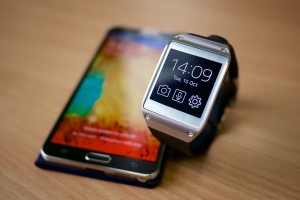Photo: Kārlis Dambrāns
A few months ago we said that the future is mobile. We were right.
Now that some of the then-future developments have actually happened, the future might not just be mobile, but also wearable.
Google has attracted a lot of interest with the first Google Glass headsets. The company has kept up with buzz by adding more and more apps and entering talks about prescription lenses for the product, which would make it accessible to a much wider audience.
But Google doesn't control the wearable device landscape, which is expanding rapidly.
Fitness trackers have been around for a while, and though Apple's iWatch remains a much discussed rumor, the Pebble Smartwatch is already available for iPhone and Android. The Pebble combines some of the features of the most sought after watches (it's waterproof, with a backlight and changeable straps and faces) with smartphone features like notifications and apps.

Photo: Kārlis Dambrāns
Meanwhile, Samsung has released the Galaxy Gear smartwatch to accompany some of its latest smartphones and tablets. For such a small device, it can do quite a lot. It can receive notifications, take voice commands and dictation, record videos, take photos and play music although it has limited storage. So far, critics are underwhelmed, but it remains a key development in the wearables market.
Being able to get at information without having to hold your phone at all seems like a natural evolution, especially if you also get to search hands-free using Google Now or, in the future, Siri.
So it's no surprise that Business Insider Intelligence predicts that wrist worn gadgets will lead a market that it estimates will soon be worth $12 billion. And the market could eventually expand to include clip on devices and ingestible wearable technology (nanobots, anyone?)
The question is, what will this mean for your business?
From where we're sitting, the wearables boom confirms the need to get mobile optimization right, creating sites that work even on tiny watch screens. It's not a stretch to think that one day people will get tired of having to carry devices around and will expect all computing to be wearable or embedded.
In fact, one young inventor is already piloting an Android-based smart watch that's more like today's smartphones. Perhaps this is the future of the smartwatch.
In a world where personal technology is wearable, local search engine optimization will be even more important, because those users will be searching for relevant information they can act on immediately. And optimizing content delivery for those devices, perhaps by creating a hybrid app, will also be a key business consideration.
While Google Glass is expected to be mainstream within a couple of years, the wearables market is still wide open, with many of the major technology companies still to show their hand.
However, a trawl through the news on patents reveals that business owners may one day have to optimize for devices that are currently just a dream.
Sony has filed a patent for a smart wig that alerts you when you get calls and text messages, while Google has gone even smaller, filing a patent for an electronic throat tattoo that would allow users to communicate with devices without needing a headset.
Now, that might be an optimization challenge!
